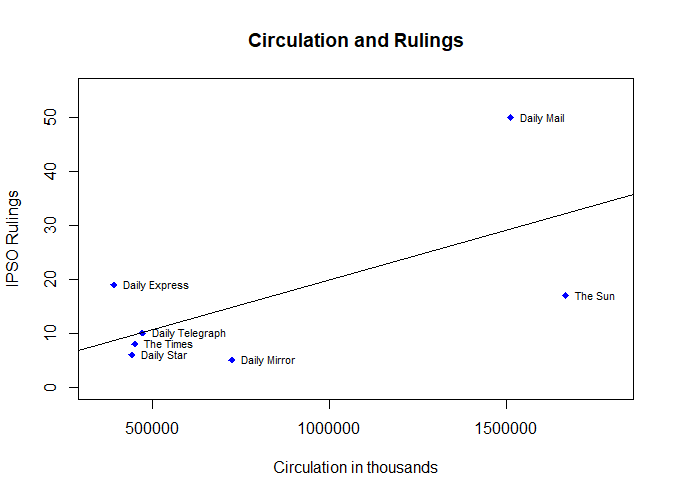Circulation And Inaccuracy
The Independent Press Standards Organisation (IPSO) publishes rulings for inaccuracy 2017. https://tabloidcorrections.wordpress.com/2018/01/02/statistics-show-that-daily-mail-was-by-far-the-most-unreliable-uk-paper-in-2017/ Is there are relationship with circulation? https://en.wikipedia.org/wiki/List_of_newspapers_in_the_United_Kingdom_by_circulation#2010_to_present
Name <- c('The Sun','Daily Mail','Daily Mirror','Daily Telegraph','The Times','Daily Star','Daily Express')
Circulation <- c(1666715,1511357,724888,472258, 451261,443452,392526)
Rulings <- c(17,50,5,10,8,6,19)
Inaccuracy <- c(16,37,2,9,7,6,17)
Newspapers <- data.frame(Name, Circulation, Rulings, Inaccuracy)
plot(Newspapers$Circulation, Newspapers$Rulings,
main="Circulation and Rulings",
xlab = "Circulation in thousands", xlim=c(350000, 1800000),
ylab = "IPSO Rulings", ylim=c(0, 55),
col="blue", pch=18)
abline(lm(Newspapers$Rulings ~ Newspapers$Circulation))
text(Circulation, Rulings, labels=Name, cex=0.7, pos=4)
cor.test(Newspapers$Rulings, Newspapers$Circulation, method="pearson")
Probably not.

Pearson's product-moment correlation
data: Newspapers$Rulings and Newspapers$Circulation
t = 1.8623, df = 5, p-value = 0.1216
alternative hypothesis: true correlation is not equal to 0
95 percent confidence interval:
-0.2183074 0.9400043
sample estimates:
cor
0.6399588
Written on January 12, 2018